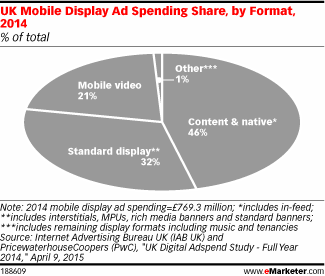As traditional display ads’ performance worsens, and platforms and publishers grow more open to nontraditional monetization methods, UK marketer investment in native advertising—that is, paid digital ad placements that look like organic content—is rising, according to a new eMarketer report, “UK Native Advertising: Growing Pains as Fledgling Format Seeks Maturity.”
Native’s awkward adolescence looks to be drawing to a close. This year, the industry is laying firmer foundations for native trading, including guidelines intended to better ensure practitioners do not mislead consumers with their native efforts. But among UK marketers, challenges persist in areas like goals, pricing, performance measurement and scalability.
Mobile devices are changing the way people in the UK access and consume content, as well as expanding the native advertising opportunity and redefining the mechanisms by which marketers must reach digital screens.
eMarketer estimates that in 2015, the average amount of time UK consumers spend daily with nonvoice activities on mobile devices will surpass time spent with PCs for the first time. Mobile devices’ touchscreens, which beckon scrolling, are prompting a reshaping of content, increasingly presented in continuously updated, chronologically reverse live feeds.
Marketers have noticed consumers’ changing behavior, devoting a large share of native ad spending to mobile efforts. According to digital ad spend figures from the Internet Advertising Bureau UK (IAB UK) and PricewaterhouseCoopers, content and native ad spending on mobile initiatives totaled £356.4 million ($586.9 million) in 2014, or 70% of all digital content and native ad spending.
That tally also means content and native accounted for the largest share of all UK mobile display ad spending—46%—outpacing mobile video (21%) and even standard display (32%). It’s a marker of how quickly these new native formats have developed and how well they fit with mobile consumption patterns and marketers’ goals.
In fact, mobile appears to drive native advertising more significantly in the UK than elsewhere. It accounted for 27% of native ads served there in June 2014, vs. 20% globally, according to data from native ad tech vendor Polar’s MediaVoice platform, which helps deliver native ads through content streams from premium publishers such as Forbes, Slate and The Telegraph.
Crucially, native ads catch consumers’ attention. In research presented at the October 2014 IAB UK Digital Upfronts, 85% of UK smartphone users studied by Yahoo noticed such ads served in mobile content streams, a rate higher than the 64% who noticed standard display formats when served on mobile. Likewise, Polar found smartphone-accessed native ads in the UK had a clickthrough rate 64% higher than those encountered via desktop, a rate more than twice the global average.
However, outcomes from mobile-delivered native ads may vary significantly. Much of the content produced by brands today is immersive and engaging—for instance, an article or a video signposted by a native ad unit link. But the mobile consumer experience is necessarily brief and intermittent, and marketer content delivered in feeds and streams naturally competes with torrents of other links and messages. Marketers, therefore, must work hard not just to reach consumers, but to keep them engaged in an environment that promotes fleeting consumption.
